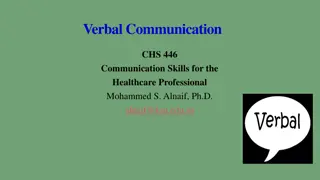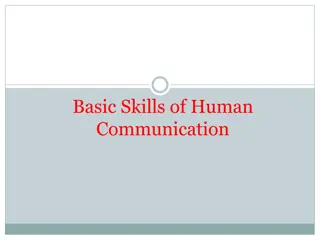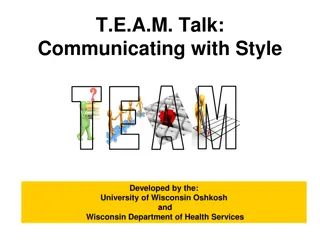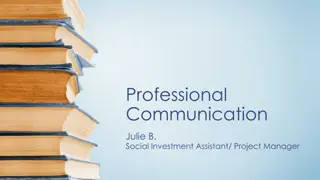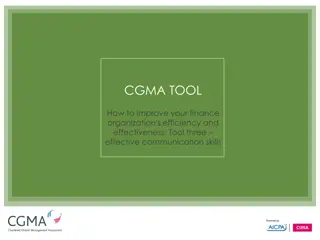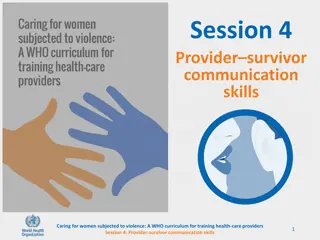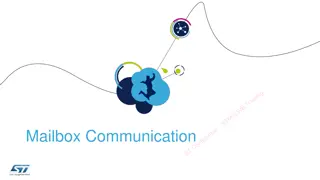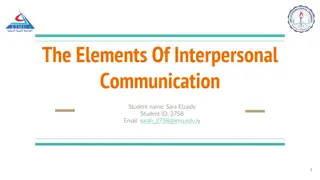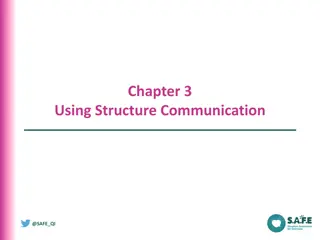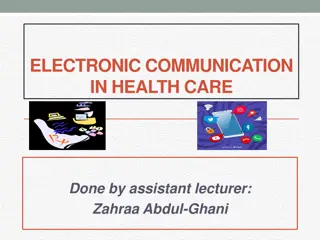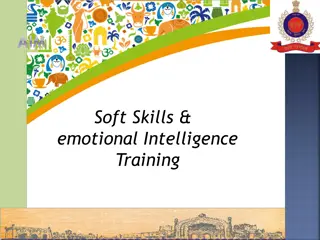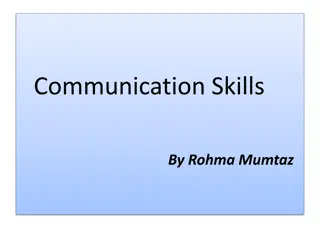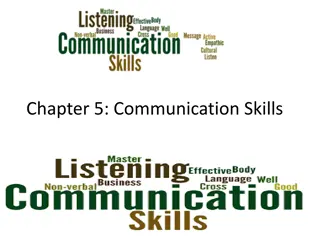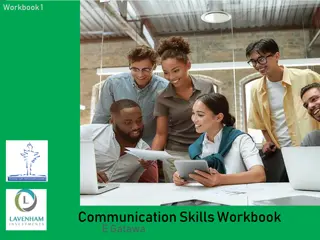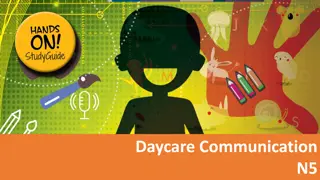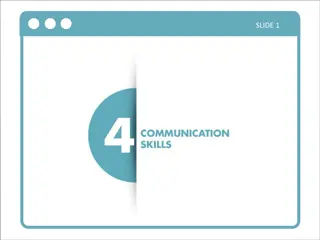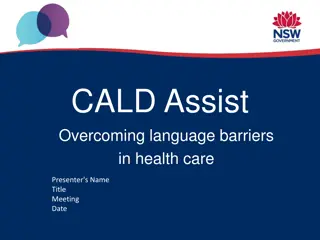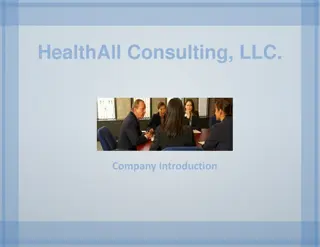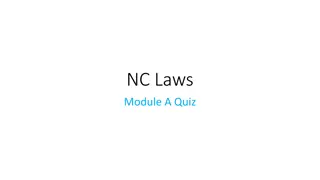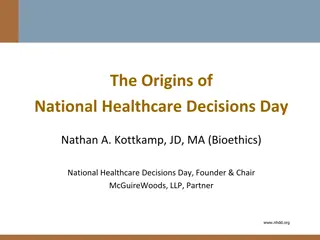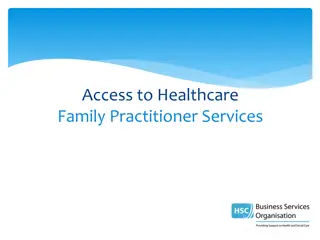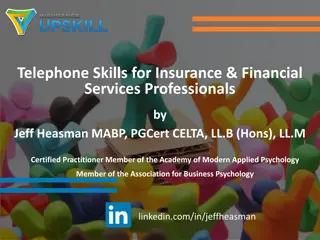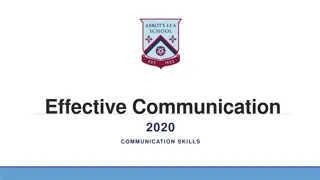Enhancing Communication Skills in Healthcare
Understanding the importance of listening and communication in healthcare settings is crucial for effective patient care and outcomes. This presentation delves into various aspects of active listening, communication skills, and the impact they have on healthcare delivery. Through real-life scenarios and expert insights, participants can improve their ability to listen actively and communicate effectively in clinical settings.
Download Presentation

Please find below an Image/Link to download the presentation.
The content on the website is provided AS IS for your information and personal use only. It may not be sold, licensed, or shared on other websites without obtaining consent from the author. Download presentation by click this link. If you encounter any issues during the download, it is possible that the publisher has removed the file from their server.
E N D
Presentation Transcript
WHAT TO EXPECT IN THIS PRESENTATION Life with the Wright Family Overview about the importance of listening 4 Types of content listening Mindless vs Mindful listening Active listening defined Key elements in active listening 3 Steps for Improving Active Listening Skills Before, During and After
IMPORTANCE OF COMMUNICATION AND SOFT SKILLS Communication is the skill that can possibly have the greatest impact on effective healthcare delivery. It really is the key to clinical governance and demands as much attention, respect and sustaining as other seemingly harder targets. However, often the mere mention of the importance of communication causes less than positive reactions in healthcare professionals. (Jelphs, 2006, senior fellow at the Health Services Management Centre at the University of Birmingham)
LIFE WITH THE WRIGHT FAMILY Please stand and quickly form a circle
WHAT DID YOU HEAR? Who didn't go on the vacation with the family? Answer: Aunt Linda Wright Why did Timmy have to run back home? Answer: Father Wright left his wallet so Timmy went to get money Who got sick in the car? Answer: Susan Wright
ON THE JOB, LISTENING IS ABOUT 60% OF OUR TIME 60% 60% Speaking 30% Speaking 30% Listening 45% Listening 45% Reading 16% Reading 16% Writing 9% Writing 9% Types of Communication Activities Types of Communication Activities Based on the research of: Adler, Rosenfeld and Proctor (2001; 2011)
LISTENING DEFINED THE PROCESS OF MAKING SENSE OF OTHERS SPOKEN MESSAGES (ADLER & PROCTOR, 2011) There s more to this than meets the ear: Hearing is NOT the same thing as listening Hearing is the act of perceiving sound Listening occurs when the brain makes sense of the original sound Listening is an active mental process that gives meaning Listening is a positive act: you have to put yourself out to do it. - David Hockney
SO, HOW DO WE LISTEN? CAN YOU HAURR ME NOW? Five Elements of the Listening Process Hearing = the physiological dimension Attending = the psychological process of selection where we decide what gets through Understanding = making sense of a message Responding = giving observable feedback to the speaker Remembering = the ability to recall information (Adler & Proctor, 2011)
4 CONTENT TYPES OF LISTENING Type of Listening Appreciative Empathetic Comprehensive Critical How is it used Pleasure or enjoyment Provide emotional support Listen to understand Listen to evaluate the message; accept or reject it (Lucas, 2012) Think about it: Sometimes based on the content, and the context, it s easier or harder to really listen. Think back to the Wright story at the beginning of the session which content type of listening would best have aided your effort to recall facts of the story?
WE CANT ALWAYS LISTEN CAREFULLY! Mindless Listening Occurs when we react to others messages automatically and routinely Mindful Listening Involves giving careful and thoughtful attention to the messages we receive (Adler & Proctor, 2011) THE CHALLENGE IS KNOWING WHEN TO BE MINDFUL: The precursor to Active Listening
ACTIVE LISTENING DEFINED The Centers for Disease Control (CDC) defines active listening as: hearing what is said and paying attention to how it is said so the conversation can be adjusted to elicit the needed response utilizing various verbal and nonverbal techniques (CDC, n.d.).
ROLE PLAYING ACTIVITY Find a partner You will each be given instructions describing your role Please do not share your instructions with your partner Once both partners have read his or her instructions begin the role play activity. Continue until instructed to stop
A FEW KEY ELEMENTS TO ACTIVE LISTENING THAT YOU PROBABLY ALREADY KNOW Take it seriously! It takes effort and commitment Provide effective feedback Body language and nonverbal communication Talk less Listen to the words, tone and feelings Listen with your eyes and ears Ask questions to clarify meaning Paraphrase to ensure your understanding Suspend judgment and evaluate thoughts Be sincerely interested in the other person
STEPS IN ACTIVE LISTENING FOR SKILLS IMPROVEMENT: A CONTINUUM Before During After
BEFORE ACTIVE LISTENING IT S NOT ALWAYS POSSIBLE BUT WHEN IT IS, PREPARATION IS HUGE. Assess yourself and your listening environment Is it conducive to mindful listening? Remove/reduce physical and mental distractions Take a moment to assume good listening posture and physically orient your body to be open Take stock of your feelings and emotions Be sincere in your desire to understand
DURING ACTIVE LISTENING Remove mental and physical distractions Cell phone off? Chewing gum out? Mind cleared? Stay quiet & let the story unfold Don t interrupt internally or externally Orient your body to face the other person Be relaxed but posture attentive and interested If sitting, lean slightly toward the person Make eye contact; maintain it as appropriate Smile, and give positive body language signals such as nodding, and nonverbal indicators such as mmhhm This thing is everywhere! A little more on body language
BODY LANGUAGE: SOME SAY ITS JUST ABOUT 65%...(BURGOON, 1994) Other s have suggested the message impact % below when messages are related to feelings and attitudes: WORDS 7% What we do know for sure is that when words and body language don t align, we believe the body language and paralanguage. Body Language 55% Tone of Voice 38% Based on the work by Albert Mehrabian
DURING ACTIVE LISTENING CONTINUED Paraphrasing: Restate the other person s comments in your own words verifying your understanding Use phrases like: What I m hearing is... and It sounds like you are saying
AFTER ACTIVE LISTENING Active Listening requires action and the action begins with a choice to improve your listening skills Be willing to review your listening and communicative exchanges and to reflect on your own performance. As with any skill, you must first want to improve, so take listening seriously & practice.
ACTIVE LISTENING PRACTICE Issues faced on the job discussion. Both partners will practice active listening.
GENERAL CAUSES OF POOR LISTENING Information overload Preoccupation Not concentrating We speak between 120 - 150 WPM We can process 400 - 800 WPM Listening too hard Jumping to conclusions Thinking you know what is coming next Rejecting prematurely External interferences We think we are good listeners We think speaking will earn more rewards than listening Focusing on personal appearance
STEPS IN ACTIVE LISTENING FOR SKILLS IMPROVEMENT: A CONTINUUM You must want to improve and that means YOU take steps and modify your own behavior It s okay to be: Mindless (at times) Mindful (as warranted) As long as you KNOW which is needed You must want to improve so reflect and revise your listening behaviors Ask other s to help! Before During After
THANK YOU! Questions? Comments?







